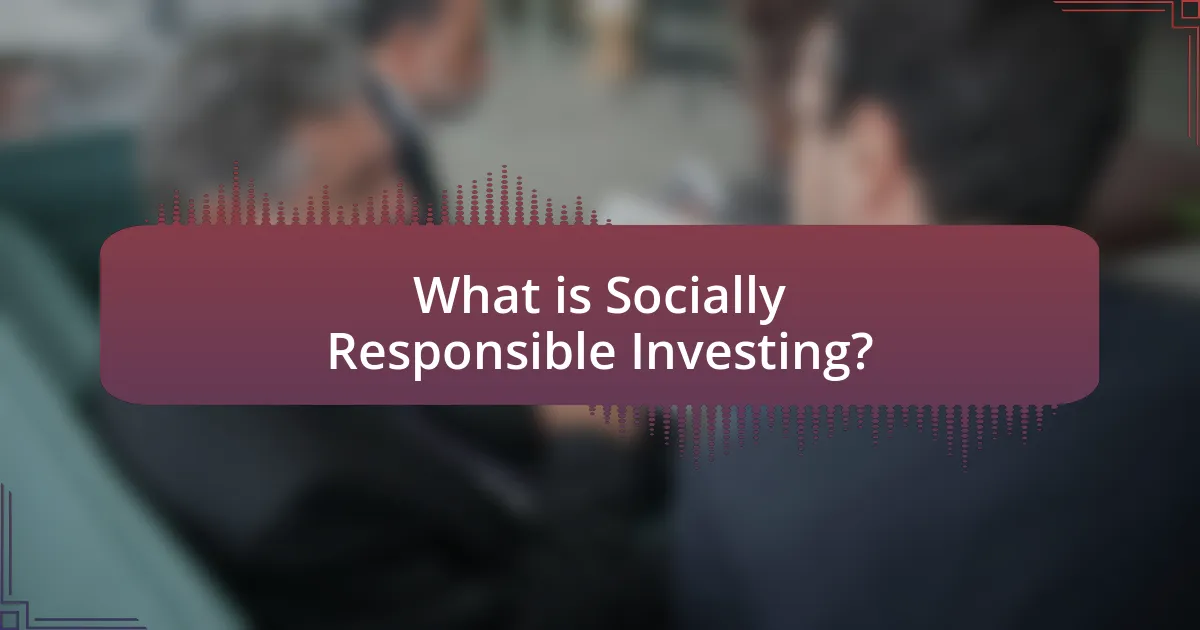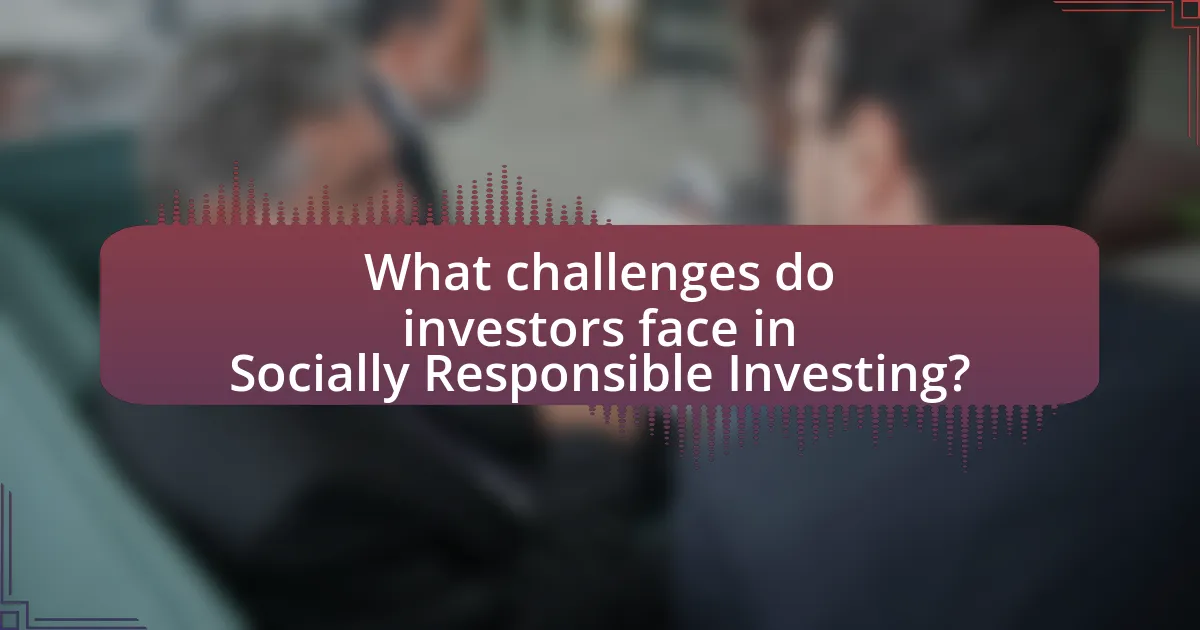Socially Responsible Investing (SRI) is an investment strategy that integrates ethical, social, and environmental considerations into financial decision-making, allowing investors to align their portfolios with personal values. The article explores the differences between SRI and traditional investing, highlighting key principles such as environmental sustainability, social equity, and corporate governance. It discusses the growing popularity of SRI, various approaches including negative and positive screening, and the potential financial benefits associated with sustainable investments. Additionally, the article addresses challenges, misconceptions, and best practices for implementing SRI strategies, providing insights into how investors can effectively measure the impact of their socially responsible investments.

What is Socially Responsible Investing?
Socially Responsible Investing (SRI) is an investment strategy that incorporates ethical, social, and environmental considerations into financial decision-making. This approach allows investors to align their portfolios with their personal values by selecting companies and funds that meet specific criteria, such as sustainability practices or social justice initiatives. Research indicates that SRI can yield competitive financial returns while promoting positive societal impact, as evidenced by a 2020 report from the Global Sustainable Investment Alliance, which found that global sustainable investment reached $30.7 trillion, reflecting a growing trend among investors to prioritize ethical considerations alongside financial performance.
How does Socially Responsible Investing differ from traditional investing?
Socially Responsible Investing (SRI) differs from traditional investing primarily by incorporating ethical, social, and environmental criteria into investment decisions. While traditional investing focuses solely on financial returns, SRI evaluates companies based on their impact on society and the environment, often excluding those involved in activities like fossil fuels, tobacco, or weapons manufacturing. For instance, a 2021 report from the Global Sustainable Investment Alliance indicated that global sustainable investment reached $35.3 trillion, reflecting a growing trend where investors prioritize values alongside financial performance.
What are the key principles of Socially Responsible Investing?
The key principles of Socially Responsible Investing (SRI) include environmental sustainability, social equity, and corporate governance. Environmental sustainability focuses on investing in companies that prioritize ecological health and reduce carbon footprints, as evidenced by the growing trend of green bonds, which reached over $1 trillion in issuance by 2020. Social equity emphasizes investing in businesses that promote fair labor practices and community development, supported by research indicating that companies with strong social responsibility records often outperform their peers financially. Corporate governance involves selecting firms with transparent practices and ethical leadership, which has been shown to correlate with lower risk and higher returns, as highlighted in studies by the Harvard Business School.
Why is Socially Responsible Investing gaining popularity?
Socially Responsible Investing (SRI) is gaining popularity due to a growing awareness of environmental, social, and governance (ESG) issues among investors. This shift is evidenced by a 2021 report from the Global Sustainable Investment Alliance, which indicated that global sustainable investment reached $35.3 trillion, a 15% increase from 2018. Investors are increasingly seeking to align their financial goals with their personal values, leading to a demand for investment options that reflect ethical considerations. Additionally, studies show that companies with strong ESG practices often outperform their peers financially, further driving interest in SRI as a viable investment strategy.
What are the different approaches to Socially Responsible Investing?
The different approaches to Socially Responsible Investing (SRI) include negative screening, positive screening, impact investing, and shareholder advocacy. Negative screening involves excluding companies or sectors that do not align with specific ethical guidelines, such as tobacco or fossil fuels. Positive screening focuses on investing in companies that meet certain social or environmental criteria, promoting those that contribute positively to society. Impact investing aims to generate measurable social or environmental benefits alongside financial returns, often targeting specific issues like renewable energy or affordable housing. Shareholder advocacy involves using shareholder power to influence corporate behavior towards more sustainable practices. These approaches collectively enable investors to align their financial goals with their personal values and ethical considerations.
How do negative screening and positive screening work?
Negative screening and positive screening are two methods used in socially responsible investing (SRI) to align investment portfolios with ethical values. Negative screening involves excluding companies or industries that do not meet specific ethical criteria, such as those involved in tobacco, firearms, or fossil fuels. This approach allows investors to avoid supporting businesses that conflict with their values. In contrast, positive screening focuses on selecting companies that actively promote social good or environmental sustainability, such as renewable energy firms or companies with strong labor practices. This method encourages investment in businesses that contribute positively to society. Both strategies are essential for investors seeking to ensure their portfolios reflect their personal values and ethical considerations.
What is impact investing and how does it relate to Socially Responsible Investing?
Impact investing is an investment strategy that aims to generate positive social and environmental impacts alongside financial returns. This approach differs from Socially Responsible Investing (SRI), which primarily focuses on avoiding investments in companies that engage in harmful practices, such as tobacco or fossil fuels. While both strategies align financial goals with ethical values, impact investing actively seeks to create measurable benefits, such as improving education or healthcare, whereas SRI emphasizes negative screening to exclude undesirable sectors. According to the Global Impact Investing Network, the impact investing market reached $715 billion in assets under management in 2020, highlighting its growing significance in the investment landscape.

Why should investors consider Socially Responsible Investing?
Investors should consider Socially Responsible Investing (SRI) because it allows them to align their financial goals with their personal values. SRI focuses on investing in companies that prioritize environmental sustainability, social justice, and ethical governance, which can lead to positive societal impacts. Research indicates that SRI can also yield competitive financial returns; for instance, a study by the Morgan Stanley Institute for Sustainable Investing found that sustainable equity funds outperformed traditional funds by 4.3% annually from 2004 to 2018. This demonstrates that investors can achieve both ethical alignment and financial performance through SRI.
What are the potential financial benefits of Socially Responsible Investing?
Socially Responsible Investing (SRI) can yield potential financial benefits such as enhanced portfolio performance and reduced risk. Studies have shown that SRI funds often perform on par with or better than traditional investments; for instance, a 2020 report by Morningstar indicated that 88% of sustainable equity funds outperformed their traditional counterparts over a 10-year period. Additionally, companies with strong environmental, social, and governance (ESG) practices tend to exhibit lower volatility and better long-term financial stability, as evidenced by research from MSCI, which found that high ESG-rated companies had lower capital costs and better operational performance. These factors contribute to the financial viability of SRI, making it an attractive option for investors seeking both ethical alignment and financial returns.
How can Socially Responsible Investing lead to long-term returns?
Socially Responsible Investing (SRI) can lead to long-term returns by focusing on companies that prioritize environmental, social, and governance (ESG) factors, which often results in better risk management and sustainable growth. Research from the Morgan Stanley Institute for Sustainable Investing indicates that sustainable equity funds outperformed traditional funds by 4.3% annually from 2004 to 2018, demonstrating that companies with strong ESG practices tend to have lower volatility and higher profitability over time. Additionally, as consumer preferences shift towards ethical products and services, companies that align with these values are likely to capture greater market share, further enhancing their long-term financial performance.
What evidence supports the performance of socially responsible funds?
Socially responsible funds have demonstrated competitive performance compared to traditional funds. Research by the Morgan Stanley Institute for Sustainable Investing found that sustainable equity funds outperformed their traditional counterparts by 3.9% annually from 2004 to 2018. Additionally, a meta-analysis published in the Journal of Sustainable Finance & Investment reviewed over 2,200 studies and concluded that socially responsible investments often yield returns equal to or better than conventional investments. These findings indicate that socially responsible funds can deliver strong financial performance while aligning with ethical values.
How does Socially Responsible Investing align with personal values?
Socially Responsible Investing (SRI) aligns with personal values by allowing individuals to invest in companies and projects that reflect their ethical beliefs and social priorities. This investment strategy emphasizes environmental sustainability, social justice, and corporate governance, enabling investors to support businesses that contribute positively to society. For instance, a 2021 report from the Global Sustainable Investment Alliance indicated that global sustainable investment reached $35.3 trillion, demonstrating a significant shift towards aligning financial decisions with personal and societal values. By choosing SRI, investors can ensure their financial growth does not come at the expense of their moral principles, thus reinforcing their commitment to a better world.
What role do personal beliefs play in investment choices?
Personal beliefs significantly influence investment choices by guiding individuals toward options that align with their values and ethics. Investors often prioritize companies or funds that reflect their personal convictions, such as environmental sustainability, social justice, or corporate governance. Research indicates that 70% of investors are interested in socially responsible investing, demonstrating a clear trend where personal beliefs shape financial decisions. This alignment not only fulfills ethical considerations but can also impact financial performance, as companies with strong social responsibility practices often exhibit lower risk and better long-term returns.
How can investors ensure their portfolios reflect their values?
Investors can ensure their portfolios reflect their values by engaging in socially responsible investing (SRI), which involves selecting investments based on ethical, social, and environmental criteria. This approach allows investors to align their financial decisions with their personal beliefs, such as prioritizing companies that promote sustainability or social justice. Research indicates that SRI strategies can lead to competitive financial returns while also fostering positive societal impact, as evidenced by a 2020 study from the Global Sustainable Investment Alliance, which reported that global sustainable investment reached $30.7 trillion, reflecting a growing trend among investors to prioritize values alongside financial performance.

What challenges do investors face in Socially Responsible Investing?
Investors face several challenges in Socially Responsible Investing (SRI), primarily including limited investment options, lack of standardized metrics for evaluating social impact, and potential trade-offs between financial returns and ethical considerations. Limited investment options arise because not all companies adhere to SRI principles, which restricts the available choices for investors. The absence of standardized metrics complicates the assessment of a company’s social and environmental performance, making it difficult for investors to compare and select suitable investments. Additionally, studies have shown that SRI can sometimes lead to lower financial returns compared to traditional investing, creating a dilemma for investors who prioritize both ethical values and financial performance.
What are the common misconceptions about Socially Responsible Investing?
Common misconceptions about Socially Responsible Investing (SRI) include the belief that it sacrifices financial returns for ethical considerations. Research from the Morgan Stanley Institute for Sustainable Investing indicates that sustainable equity funds often perform as well as or better than traditional funds, dispelling the myth that ethical investing leads to lower returns. Another misconception is that SRI is only for wealthy individuals; however, a 2020 report by the Global Sustainable Investment Alliance shows that SRI is increasingly accessible to a broader range of investors. Additionally, some believe that SRI only focuses on negative screening, but many strategies also include positive impact investing, which actively seeks to support companies with beneficial social and environmental practices.
How can investors overcome the perceived limitations of Socially Responsible Investing?
Investors can overcome the perceived limitations of Socially Responsible Investing (SRI) by diversifying their portfolios to include a mix of SRI and traditional investments. This strategy allows investors to maintain financial performance while aligning with their ethical values. Research indicates that SRI funds have performed comparably to traditional funds; for example, a study by the Morgan Stanley Institute for Sustainable Investing found that sustainable equity funds outperformed their traditional counterparts by 3.9% annually from 2004 to 2018. Additionally, investors can utilize impact measurement tools to assess the social and environmental outcomes of their investments, thereby enhancing transparency and accountability. By actively engaging with companies through shareholder advocacy, investors can influence corporate behavior and drive positive change, further mitigating the limitations associated with SRI.
What are the risks associated with Socially Responsible Investing?
The risks associated with Socially Responsible Investing (SRI) include potential lower financial returns, limited investment options, and the challenge of accurately assessing a company’s social and environmental impact. Financial returns may be lower because SRI often excludes certain sectors, such as fossil fuels, which can lead to underperformance compared to broader market indices. Limited investment options arise as SRI focuses on companies that meet specific ethical criteria, potentially reducing diversification. Additionally, assessing a company’s social responsibility can be subjective, leading to misalignment between investor values and actual company practices. These factors highlight the complexities and potential downsides of SRI.
How can investors effectively implement Socially Responsible Investing strategies?
Investors can effectively implement Socially Responsible Investing (SRI) strategies by integrating environmental, social, and governance (ESG) criteria into their investment decisions. This involves selecting investments based on their performance in these areas, which can be assessed through ESG ratings provided by various research firms. For instance, a study by MSCI found that companies with high ESG ratings tend to exhibit lower volatility and better long-term performance, indicating that SRI can align financial returns with ethical considerations. Additionally, investors can utilize SRI-focused mutual funds or exchange-traded funds (ETFs) that specifically target companies meeting these criteria, further streamlining the investment process.
What tools and resources are available for socially responsible investors?
Socially responsible investors have access to various tools and resources designed to facilitate ethical investment decisions. These include ESG (Environmental, Social, and Governance) rating agencies such as MSCI and Sustainalytics, which evaluate companies based on their sustainability practices. Additionally, investment platforms like Betterment and Wealthsimple offer socially responsible investment portfolios that align with specific values. Furthermore, financial publications and databases, such as Morningstar and Bloomberg, provide insights and data on socially responsible funds. These resources enable investors to make informed choices that reflect their ethical considerations.
How can investors measure the impact of their Socially Responsible Investments?
Investors can measure the impact of their Socially Responsible Investments (SRI) through various metrics and frameworks that assess environmental, social, and governance (ESG) factors. One effective method is using ESG ratings provided by agencies such as MSCI or Sustainalytics, which evaluate companies based on their sustainability practices and social impact. Additionally, investors can utilize impact measurement frameworks like the Global Impact Investing Network’s (GIIN) IRIS+ system, which offers standardized metrics for assessing social and environmental performance. Research indicates that companies with high ESG ratings often demonstrate better financial performance, supporting the notion that responsible investing can yield positive returns while aligning with investors’ values.
What are best practices for successful Socially Responsible Investing?
Best practices for successful Socially Responsible Investing (SRI) include thorough research, clear investment criteria, and ongoing evaluation of portfolio performance. Investors should start by identifying their values and the specific social or environmental issues they wish to support, such as climate change or human rights. This clarity allows for the selection of investments that align with these values.
Additionally, utilizing established SRI frameworks, such as the Global Reporting Initiative or the Principles for Responsible Investment, can guide investors in assessing companies’ sustainability practices. Regularly reviewing and adjusting the portfolio based on performance metrics and changing social landscapes ensures that investments remain aligned with the investor’s values and goals.
Research indicates that SRI can yield competitive financial returns; for instance, a study by the Morgan Stanley Institute for Sustainable Investing found that sustainable equity funds outperformed traditional funds by 3.9% annually from 2004 to 2018. This evidence supports the effectiveness of SRI practices in achieving both financial and ethical objectives.
How can investors stay informed about trends in Socially Responsible Investing?
Investors can stay informed about trends in Socially Responsible Investing (SRI) by regularly following reputable financial news sources, subscribing to specialized SRI newsletters, and engaging with industry reports from organizations like the Global Sustainable Investment Alliance. These sources provide timely updates on market trends, regulatory changes, and emerging investment opportunities in SRI. For instance, the Global Sustainable Investment Review, published every two years, offers comprehensive data on the growth and performance of sustainable investments, highlighting the increasing interest and capital flow into SRI strategies.
What steps can investors take to build a diversified socially responsible portfolio?
Investors can build a diversified socially responsible portfolio by identifying their values, researching socially responsible investment options, and allocating funds across various asset classes. First, investors should define their specific social and environmental values, such as sustainability, diversity, or community impact, to guide their investment choices. Next, they can research investment vehicles like mutual funds, exchange-traded funds (ETFs), or individual stocks that prioritize these values, often indicated by ESG (Environmental, Social, and Governance) ratings. Finally, investors should diversify their investments across different sectors and asset classes, such as equities, fixed income, and real estate, to mitigate risk while aligning their portfolio with their ethical standards. This approach not only supports responsible companies but also enhances the potential for financial returns, as studies have shown that socially responsible investments can perform comparably to traditional investments.





